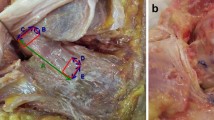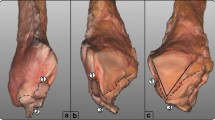Abstract
Introduction
Damage to the bifurcate ligament is one of the most difficult injuries to diagnose from imaging techniques. A probable reason for this is that the morphological characteristics of this structure have yet to be sufficiently elucidated. We, therefore, endeavored to elucidate the morphological characteristics of the bifurcate ligament through a large-scale study involving numerous specimens.
Materials and Methods
This study included 100 feet from 52 formalin-fixed cadavers. The bifurcate ligament was classified into three types: presence of both calcaneonavicular ligament and calcaneocuboid ligament (Type I); absence of calcaneocuboid ligament (Type II); and absence of calcaneonavicular ligament (Type III). Morphological characteristics of the bifurcate ligament were determined by measuring fiber bundle length, width, and thickness at the center of each ligament.
Results
This classification resulted in 68 Type I feet (68%), 32 Type II feet (32%), and 0 Type III feet (0%). The calcaneonavicular ligament was 20.8 ± 2.9 mm long, 4.9 ± 1.2 mm wide, and 3.8 ± 1.1 mm thick. The calcaneocuboid ligament was approximately 10.5 ± 2.7 mm long, 4.7 ± 2.4 mm wide, and 1.5 ± 0.6 mm thick. The bifurcate ligament was located deep under the extensor hallucis brevis and extensor digitorum brevis muscles in all specimens. The calcaneal origin of the calcaneonavicular ligament was situated deep under the interosseous talocalcaneal ligament in all specimens. Two sides were identified in which the calcaneocuboid ligament was located deep under the dorsal calcaneocuboid ligament.
Conclusion
Such variations and positional relationships were suggested to be factors complicating the diagnostic imaging of bifurcate ligament injuries. The present study results will likely form useful basic data for diagnostic imaging.


Similar content being viewed by others
References
Hovelacque A, Sourdin A (1933) Note au sulet de quelques ligaments de l’articulation medio-tarsienne. Ann Anat Pthol Anat Normal 10:469–475
Kokturk (1957) Remarques sur le ligament de Chopart. Comptes-Rendus Assoc Anat 44:380–385
Ruland WO, Schwering L, Hampe T, Rittchen A (1995) Injuries of the bifurcate ligament. Unfallchirurg 98:640–644
Acknowledgements
This study was supported by a Research Activity Young B Grant (20632326) from the Japan Society for the Promotion of Science (JSPS) and a Grant- in- Aid program from Niigata University of Health and Welfare (H28C3).
Funding
This study was supported by a Research Activity Young B Grant (17K13072) from the Japan Society for the Promotion of Science (JSPS) and a Grant-in-Aid program from Niigata University of Health and Welfare (H29C08).
Author information
Authors and Affiliations
Contributions
ME, MI and FK contributed to study design and data collection, and drafted the manuscript; TK and TT contributed to data analysis and made critical revisions to the manuscript; RH and TI made critical revisions to the manuscript; IK supervised the study, contributed to analysis and interpretation of data, and made critical revisions to the manuscript. All authors read and approved the final manuscript. All authors read and approved the final manuscript prior to submission.
Corresponding author
Ethics declarations
Conflict of interest
The authors declare that they have no competing interests.
Ethics approval
The methods were carried out in accordance with the 1964 Helsinki declaration and the cadavers were legally donated for the research by the Nippon Dental University of Life Dentistry at Niigata in Japan.
Informed consent
Informed consent was obtained from the families of all subjects.
Data availability
The datasets generated during and/or analysed during the current study are available from the corresponding author on reasonable request.
Rights and permissions
About this article
Cite this article
Edama, M., Ikezu, M., Kaneko, F. et al. Morphological features of the bifurcated ligament. Surg Radiol Anat 41, 3–7 (2019). https://doi.org/10.1007/s00276-018-2089-y
Received:
Accepted:
Published:
Issue Date:
DOI: https://doi.org/10.1007/s00276-018-2089-y




